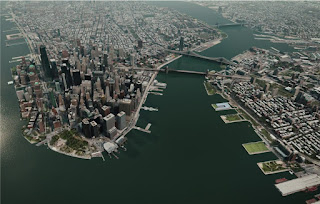Are you looking for a way to make better decisions in your
business or organization? If so, you may want to consider geospatial imagery
analytics. This innovative technology allows you to gather and analyze data
from satellite and drone imagery to gain insights into various aspects of your
business or industry. In this article, we will explore what geospatial imagery
analytics is and how it can be used to enhance decision-making.
What is Geospatial Imagery Analytics?
Geospatial
imagery analytics is a process that involves analyzing satellite and
drone imagery to extract useful insights and information. It involves using
advanced algorithms and machine learning techniques to analyze large amounts of
data quickly and accurately. The data can be used to understand trends,
patterns, and anomalies in a variety of fields, from agriculture and forestry
to urban planning and national security.
How Does Geospatial Imagery Analytics Work?
Geospatial imagery analytics involves three key steps: data
acquisition, data processing, and data analysis.
1. Data Acquisition
The first step in geospatial imagery analytics is to acquire the
necessary data. This can be done using satellite imagery or drones.
Satellite imagery is collected by satellites orbiting the earth.
There are many different types of satellites, each with its own set of
capabilities. Some satellites can capture images at very high resolutions,
while others can capture images in different parts of the electromagnetic
spectrum, such as infrared or microwave.
Drones, on the other hand, are unmanned aerial vehicles that can
be used to capture high-resolution images of a specific area. They are
particularly useful for capturing images in areas that are difficult or
dangerous to access, such as mountainous regions or disaster zones.
2. Data Processing
Once the data has been acquired, it needs to be processed to
prepare it for analysis. This involves removing any noise or distortion from
the images and aligning them so that they can be compared to each other.
3. Data Analysis
The final step in geospatial imagery analytics is to analyze the
data. This involves using machine learning algorithms to extract meaningful
insights from the data. The algorithms can be used to identify patterns, detect
changes over time, and predict future trends.
Applications of Geospatial Imagery Analytics
Geospatial imagery analytics has many applications in various
industries. Let's take a look at some of the most common ones.
1. Agriculture
Geospatial imagery analytics can be used to monitor crop health
and predict yields. By analyzing satellite or drone imagery of a field, farmers
can identify areas where crops are not growing as well as they should be. They
can then take corrective action, such as adjusting irrigation or applying fertilizer,
to improve the health of the crops.
2. Forestry
Geospatial imagery analytics can be used to monitor forest health
and predict the risk of wildfires. By analyzing satellite or drone imagery of a
forest, forest managers can identify areas where trees are stressed or dying.
They can then take action to mitigate the risks of wildfires, such as thinning
out dense areas of trees.
3. Urban Planning
Geospatial imagery analytics can be used to monitor urban
development and plan for future growth. By analyzing satellite or drone imagery
of a city, urban planners can identify areas where new infrastructure is
needed, such as roads or public transportation. They can also identify areas
where the population is growing rapidly and plan for new housing developments.
4. National Security
Geospatial imagery analytics can be used to monitor potential
threats to national security. By analyzing satellite or drone imagery of a
region, intelligence agencies can identify potential terrorist activity or
military movements. They can then take action to prevent or mitigate any
potential threats.
Advantages of Geospatial Imagery Analytics
Geospatial imagery analytics has several advantages over
traditional methods of data analysis. Let's take a look at some of them.
1. Speed
Geospatial imagery analytics can analyze large amounts of data in
a short amount of time. This allows businesses and organizations to make
decisions quickly and respond to changes in the market or environment.
2. Accuracy
Geospatial imagery analytics can provide highly accurate data,
thanks to the use of advanced algorithms and machine learning techniques. This
can help businesses and organizations make more informed decisions and avoid
costly mistakes.
3. Cost-Effective
Geospatial imagery analytics can be a cost-effective way to gather
and analyze data. While the initial investment in equipment and software can be
high, the long-term benefits of the technology can outweigh the costs.
4. Flexibility
Geospatial imagery analytics can be used in a variety of industries
and applications. This makes it a flexible technology that can adapt to the
needs of different businesses and organizations.
Challenges of Geospatial Imagery Analytics
While geospatial imagery analytics has many advantages, it also
presents several challenges. Let's take a look at some of them.
1. Data Quality
The quality of the data used in geospatial imagery analytics can
vary greatly. Low-quality data can lead to inaccurate results and poor
decision-making.
2. Data Processing
Processing large amounts of data can be time-consuming and
resource-intensive. This can be a challenge for businesses and organizations
with limited resources.
3. Technical Expertise
Geospatial imagery analytics requires technical expertise in areas
such as satellite and drone technology, image processing, and machine learning.
This expertise can be difficult to find and can be expensive to hire.
Conclusion
Geospatial imagery analytics is an innovative technology that can
help businesses and organizations make better decisions by providing them with
useful insights and information. The technology has many applications in
various industries, including agriculture, forestry, urban planning, and
national security. While geospatial imagery analytics presents several
challenges, the benefits of the technology outweigh the costs.
So, if you're looking for a way to enhance your decision-making capabilities, geospatial imagery analytics may be the solution you're looking for.

